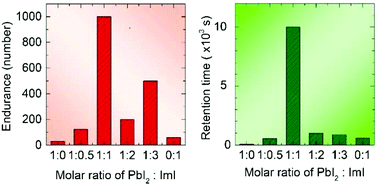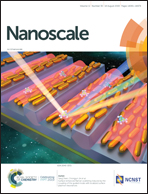The effect of compositional engineering of imidazolium lead iodide on the resistive switching properties
Abstract
We report here resistive switching memory characteristics of imidazolium lead iodide depending on the molar ratio of PbI2 to imidazolium iodide (ImI), that is, PbI2 : ImI = 1 : 0, 1 : 0.5, 1 : 1, 1 : 2, 1 : 3 and 0 : 1. X-ray diffraction confirms that the stoichiometric composition results in a hexagonal structure of (Im)PbI3, showing a one-dimensional face-sharing [PbI3−] chain. Bipolar resistive switching characteristics are observed regardless of the mixing ratio, where the forming process is required prior to SET and RESET processes at around +0.2 V and −0.2 V, respectively. The ON/OFF ratio is increased from 106 to 109 as the ImI content is increased due to the increased HRS associated with the pronounced insulating characteristics by ImI, whereas, the stoichiometric (Im)PbI3 exhibits 5 times longer endurance (103) and an order of magnitude longer retention time (104 s) as compared to other compositions. Multilevel data storage capability is confirmed by changing the compliance current. The low resistance state (LRS) and the high resistance state (HRS) are associated with Ohmic conduction and Schottky conduction, respectively. Density functional theory (DFT) calculation reveals that the defect formation energy of iodine vacancy is estimated to be low indicating that (Im)PbI3 has a sufficient concentration of iodide vacancy for filament formation. Further energy barrier calculations show that iodide migration preferentially occurs along the 1-dimensional [234] crystallographic direction rather than the interlayer [130] direction. A good performance of the (Im)PbI3-based memristor is thus related to the low defect formation energy of iodide vacancy and the preferential growth of the filament along the 1-dimensional chain.



 Please wait while we load your content...
Please wait while we load your content...